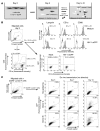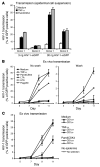TNF-alpha and TLR agonists increase susceptibility to HIV-1 transmission by human Langerhans cells ex vivo
- PMID: 18776939
- PMCID: PMC2528910
- DOI: 10.1172/JCI34721
TNF-alpha and TLR agonists increase susceptibility to HIV-1 transmission by human Langerhans cells ex vivo
Abstract
Genital coinfections increase an individual's risk of becoming infected with HIV-1 by sexual contact. Several mechanisms have been proposed to explain this, such as the presence of ulceration and bleeding caused by the coinfecting pathogen. Here we demonstrate that Langerhans cells (LCs) are involved in the increased susceptibility to HIV-1 in the presence of genital coinfections. Although LCs are a target for HIV-1 infection in genital tissues, we found that immature LCs did not efficiently mediate HIV-1 transmission in an ex vivo human skin explant model. However, the inflammatory stimuli TNF-alpha and Pam3CysSerLys4 (Pam3CSK4), the ligand for the TLR1/TLR2 heterodimer, strongly increased HIV-1 transmission by LCs through distinct mechanisms. TNF-alpha enhanced transmission by increasing HIV-1 replication in LCs, whereas Pam3CSK4 acted by increasing LC capture of HIV-1 and subsequent trans-infection of T cells. Genital infections such as Candida albicans and Neisseria gonorrhea not only triggered TLRs but also induced TNF-alpha production in vaginal and skin explants. Thus, during coinfection, LCs could be directly activated by pathogenic structures and indirectly activated by inflammatory factors, thereby increasing the risk of acquiring HIV-1. Our data demonstrate a decisive role for LCs in HIV-1 transmission during genital coinfections and suggest antiinflammatory therapies as potential strategies to prevent HIV-1 transmission.
Figures







Similar articles
-
Human immature Langerhans cells restrict CXCR4-using HIV-1 transmission.Retrovirology. 2014 Jul 2;11:52. doi: 10.1186/1742-4690-11-52. Retrovirology. 2014. PMID: 24990163 Free PMC article.
-
Gram-positive bacteria enhance HIV-1 susceptibility in Langerhans cells, but not in dendritic cells, via Toll-like receptor activation.Blood. 2009 May 21;113(21):5157-66. doi: 10.1182/blood-2008-10-185728. Epub 2009 Mar 11. Blood. 2009. PMID: 19279330
-
HIV-1 exposure and immune activation enhance sexual transmission of Hepatitis C virus by primary Langerhans cells.J Int AIDS Soc. 2019 Mar;22(3):e25268. doi: 10.1002/jia2.25268. J Int AIDS Soc. 2019. PMID: 30932366 Free PMC article.
-
Human immunodeficiency virus-1 acquisition in genital mucosa: Langerhans cells as key-players.J Intern Med. 2009 Jan;265(1):18-28. doi: 10.1111/j.1365-2796.2008.02046.x. J Intern Med. 2009. PMID: 19093957 Review.
-
Langerhans cell and HIV.Nihon Rinsho Meneki Gakkai Kaishi. 2011;34(2):70-5. doi: 10.2177/jsci.34.70. Nihon Rinsho Meneki Gakkai Kaishi. 2011. PMID: 21628848 Review. English, Japanese.
Cited by
-
Learning from the messengers: innate sensing of viruses and cytokine regulation of immunity - clues for treatments and vaccines.Viruses. 2013 Jan 31;5(2):470-527. doi: 10.3390/v5020470. Viruses. 2013. PMID: 23435233 Free PMC article. Review.
-
Human TRIM5α: Autophagy Connects Cell-Intrinsic HIV-1 Restriction and Innate Immune Sensor Functioning.Viruses. 2021 Feb 19;13(2):320. doi: 10.3390/v13020320. Viruses. 2021. PMID: 33669846 Free PMC article. Review.
-
Alarmin S100A9 restricts retroviral infection by limiting reverse transcription in human dendritic cells.EMBO J. 2021 Aug 16;40(16):e106540. doi: 10.15252/embj.2020106540. Epub 2021 Jun 14. EMBO J. 2021. PMID: 34121210 Free PMC article.
-
Vaginal bacterium Prevotella timonensis turns protective Langerhans cells into HIV-1 reservoirs for virus dissemination.EMBO J. 2022 Oct 4;41(19):e110629. doi: 10.15252/embj.2022110629. Epub 2022 Aug 15. EMBO J. 2022. PMID: 35968812 Free PMC article.
-
The Penis, the Vagina and HIV Risk: Key Differences (Aside from the Obvious).Viruses. 2022 May 27;14(6):1164. doi: 10.3390/v14061164. Viruses. 2022. PMID: 35746636 Free PMC article. Review.
References
-
- Joint United Nations Programme on HIV/AIDS and World Health Organisation 2007. 2007 AIDS epidemic update. http://www.unaids.org .
Publication types
MeSH terms
Substances
Grants and funding
LinkOut - more resources
Full Text Sources
Other Literature Sources
Medical

